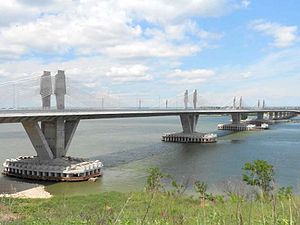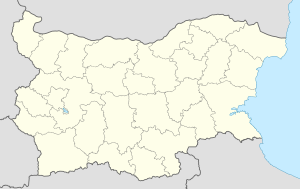Danube Bridge 2
Coordinates: 44 ° 0 ′ 21 ″ N , 22 ° 56 ′ 50 ″ E
| Danube Bridge 2 Bridge New Europe |
||
|---|---|---|
| The Danube Bridge 2 (August 2012) from the Romanian bank. | ||
| Official name | Vidin-Calafat Bridge | |
| use | Railway and road bridge | |
| Convicted | the following modes of transport: * single-track railway line * 2 lanes per direction for road traffic * combined pedestrian and cycle path | |
| Crossing of | Danube , km 796 | |
| place | Vidin , Calafat | |
| construction | Cable- stayed bridge , extradosed bridge | |
| overall length | 3598 m (1791 m of which over the Danube) | |
| width | 31.35 m | |
| Longest span | 180 m | |
| height | 44.77 m | |
| building-costs | € 146 million | |
| start of building | 2007 | |
| completion | October 2012 | |
| opening | 14th of June 2013 | |
| planner | Carlos Fernández Casado SL | |
| location | ||
|
|
||
The Danube Bridge 2 (Bridge "New Europe"), also called the Vidin – Calafat Bridge ( Bulgarian Дунав мост 2 , or Мост Видин-Калафат ; Romanian Podul Calafat-Vidin) is a bridge over the Danube between the Bulgarian city of Vidin and the Romanian one Calafat . Along with the Giurgiu-Russe Friendship Bridge, it is the second fixed crossing of the Danube between the two countries and part of the Pan-European Transport Corridor IV.
At this point the Romanian bank is higher than the Bulgarian, which is protected by dikes.
history
The first project for the construction of a second bridge over the Danube between Romania and Bulgaria was approved in 1974 and should take place between Turnu Măgurele and Nikopol . At the beginning of the 1990s, during the embargo due to the Yugoslav wars , the plan was up for discussion again.
New connections between Romania and Bulgaria were discussed, with Bulgaria advocating for the most western bridges possible, Romania for a central location as possible (from west to east) :
At the beginning of 2000, both countries were able to agree on a building near Vidin - Calafat as part of the stability pact for south-eastern Europe . Between 2001 and 2003, the economic viability and financing options were examined and geological investigations were carried out. After the approval of the financing, which was largely taken over by Bulgaria, the Spanish Fomento de Construcciones y Contratas was commissioned with the construction at the beginning of 2007 after a call for tenders carried out in 2006 . Construction should be finished by 2010, but the schedule has been extended due to the geological structure and the delayed Romanian building permit. On December 20, 2012, the shell was finally handed over to the client. Follow-up work in the area of track and road construction followed.
The official opening took place on June 14, 2013. The second bridge over the Danube, which was christened New Europe , was opened to traffic at midnight, ie Saturday on June 15, 2013 at midnight.
Crossing the bridge was free until the end of June. The use of the bridge is still free of charge for pedestrians and cyclists, a toll is charged for crossing with motor vehicles . Until now, transport companies for trips to Western Europe had to choose between the long detour via Ruse or the long waiting times for customs at the Serbian border in order to bypass the expensive ferry at Vidin, which only runs hourly. The car ferry price at that time was EUR 30, for trucks EUR 105.
On October 28, 2013, serious construction defects on the bridge became known: There were potholes in the asphalt because the drainage was not good. According to headlines in the media, there was a risk of collapse, but this was greatly exaggerated. There was a risk that water under the loosening asphalt layer could penetrate the concrete of the bridge through the damaged waterproofing, which in winter could have damaged the load-bearing parts of the construction. By intervening in time, such consequential damage could be prevented. Because no guarantee or recourse obligation had been agreed with the Spanish construction company FCC, the neighboring countries will probably have to pay for the renovation.
toll
The following tolls have been levied since July 1, 2013:
| Vehicle type | Lei | Lev | Euro |
|---|---|---|---|
| Cars up to 8 + 1 seats, up to 3.5 t | 27 | 12 | 6th |
| Trucks up to 7.5 t, buses with 9 to 23 seats | 54 | 23 | 12 |
| Trucks up to 12 t | 81 | 35 | 18th |
| Trucks over 12 t with up to 3 axles; Buses over 23 seats | 113 | 49 | 25th |
| Trucks over 12 t over 3 axles | 167 | 72 | 37 |
| Pedestrians, cyclists | free | ||
Road connection
The new bridge with its four lanes is greatly oversized compared to the rest of the local infrastructure. The dimensions of the two-way connection to the road network dates from the early 20th century. Until 2013, when there was only one ferry as a cross-border connection, this corresponded to the low traffic volume.
Bulgaria
For the trunk road 1 / E 79 Botevgrad - Montana - Vidin, the expansion to the expressway (Bulgarian skorosten păt ) is planned. So far, it is 200 kilometers or three hours' drive from the Bulgarian bridge exit north of Vidin to the next high-level road, the A2 motorway near Botevgrad / Trudowez. There are hardly any bypasses on the route, so the heavy traffic leads through the centers of smaller towns. Only Vidin and Botevgrad have a complete bypass, in Montana and Wraza currently (2015) the western section is still missing.
The topographically shortest connection between Vidin and Sofia, the highway 81 Montana - Berkowiza - Kostinbrod - Sofia with the Petrochanski Prochod mountain pass over the Balkan Mountains , is closed to trucks over 10 tonnes gross vehicle weight and primarily opens up the Gornata Korija nature reserve (Горната кория). The heavy goods traffic is routed between Montana and Sofia via Wraza and Botewgrad , a future expansion with tunnels is not expected on the I / 81. Due to its current route, the route does not offer any significant reduction in travel time.
Romania
On the Romanian side, there is preliminary planning for an A6 motorway from Calafat north to Lugoj (there connection to A1 ), whereby a motorway junction with a future motorway leading to Bucharest ( A7 motorway ) is to be built initially around 50 km north of the Danube bridge at Craiova .
The shortest route from Calafat to Timisoara and Szeged (Hungary) currently leads from Maglavit via the Drum național 56A road , through numerous villages and via Vânju Mare , to Drobeta Turnu Severin , where it is via the Drum național 6 / E70 over the Western Carpathians and through some hairpin bends at Domaşnea and Plugova, continue to the A1 / A6 motorway triangle at Lugoj. Truck traffic from Calafat to Drobeta Turnu Severin is diverted via Drum național 56 to Craiova, because trucks are prohibited on Drum național 56A. On trunk road 6 / E70, bypasses were built in Drobeta Turnu Severin, Caransebeş and Lugoj.
railroad
The Calafat – Craiova and Widin – Mezdra – Sofia railway lines connect to the Danube Bridge . While the single-track rail connection over the Danube is designed for a maximum operating speed of 160 km / h and is electrified with 25 kV at 50 Hz and equipped with ETCS , the landside connecting lines on the Bulgarian side are max. 70 km / h with 225 kN axle load, on the Romanian side 100 km / h with 200 kN axle load . The line between Calafat and Craiova is not electrified . Signaling and communication systems ( ERTMS ) also do not yet meet the requirements for a future route of the TEN-T core network corridor Orient / East Mediterranean . In the 2016 timetable, however, only one pair of passenger trains runs daily, 480/481 Vidin – Budapest and back. This pair of trains continues to operate as a through car connection on a regional train from / to Sofia.
financing
Total costs and their sources
The cost of the entire bridge was around 300 million euros. Of this, 225 million euros were incurred on the Bulgarian side and 48 million euros on the Romanian side. The Bulgarian part was financed as follows:
- 70 million euros - EU program ISPA
- 70 million euros - loan from the European Investment Bank
- 5 million euros - loan from the Agence Française de Développement
- 20 million euros - from the Reconstruction Loan Corporation , including 18 million loans
- 60 million euros - from the Bulgarian state budget.
The Romanian share was also largely financed from the EU program ISPA.
Costs and their distribution
- Total project cost EUR 256 million
- Planning and construction of the bridge 146 million euros
- Construction supervision of the bridge 18 million euros
- Infrastructure feeder EUR 77 million
- Construction supervision of the infrastructural feeder 6.5 million euros
- Project management 8 million euros
- Purchase of land 1 million euros
See also
Web links
- Website of the operator of the Danube Bridge 2
- Website about the construction of the Danube Bridge 2 (multilingual)
- The German-language business paper for Bulgaria announces the opening of the bridge in November 2012
- Bridge Calafat-Vidin filmed in January 2013 - the opening date has been postponed several times , can be seen on YouTube
Individual evidence
- ↑ a b c d The residents of Widin and Calafat can visit each other across the Danube bridge. mediapool.bg, October 24, 2012, accessed October 24, 2012 (Bulgarian).
- ↑ Bridge No. 2 is supposed to overcome borders and hurdles in DerStandard of January 9, 2013
- ↑ Ortenaukreis: Vidin . In: Badische Zeitung . Retrieved May 8, 2012 .; 18 meters gap in the bridge , novinite.com, October 3, 2012
- ↑ a b The bridge in nowhere. In: tagesschau.de . June 14, 2013, archived from the original on June 18, 2013 ; Retrieved June 14, 2013 .
- ↑ a b Chronology of the Danube Bridge 2. Dnevnik , October 24, 2012, accessed on October 24, 2012 (Bulgarian).
- ^ Danube: Building a bridge awakens hope , Schweizer Radio und Fernsehen from June 14, 2013, accessed on June 22, 2013
- ↑ Commissioner Hahn welcomes the opening of the “New Europe” bridge as a powerful symbol of European cooperation.
- ↑ First drive by car over the Danube bridge 2, from Nedy Bulgaru and Gusterbo .
- ↑ До края на месеца важи гратисния период, в който преминаващите по моста водачи не заплащат такса , а след това тази привилегия остава само за велосипедисти и пешеходци .
- ↑ New Danube bridge between Bulgaria and Romania threatens to collapse
- ↑ a b Danube Bridge New Europe is threatened with collapse on krone.at
- ↑ Information from the operator of Danube Bridge 2 , accessed on November 4, 2016 (English).
- ↑ a b c d e f g Общата стойност на разходите за проектирането и строителството на “Дунав мойност на разходите везлиз 2013.


